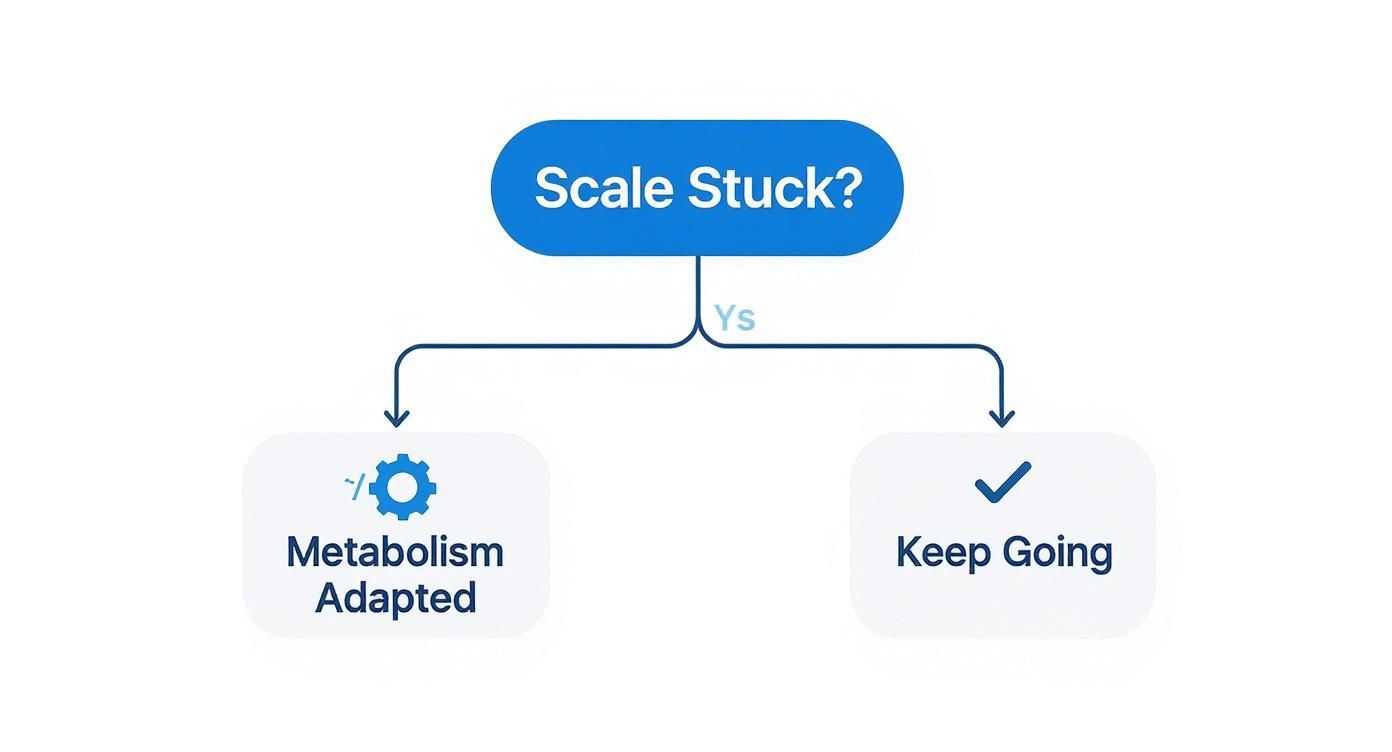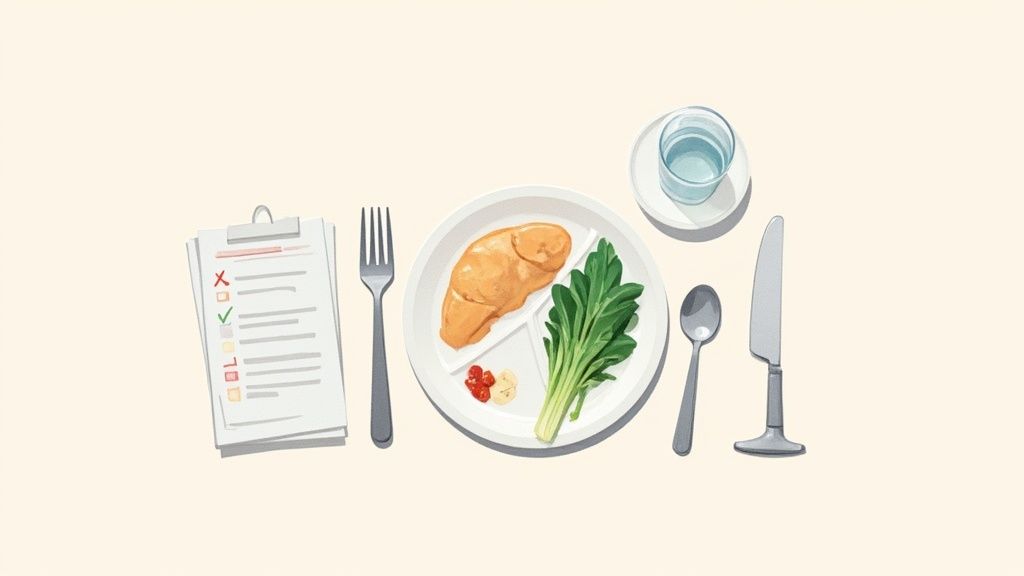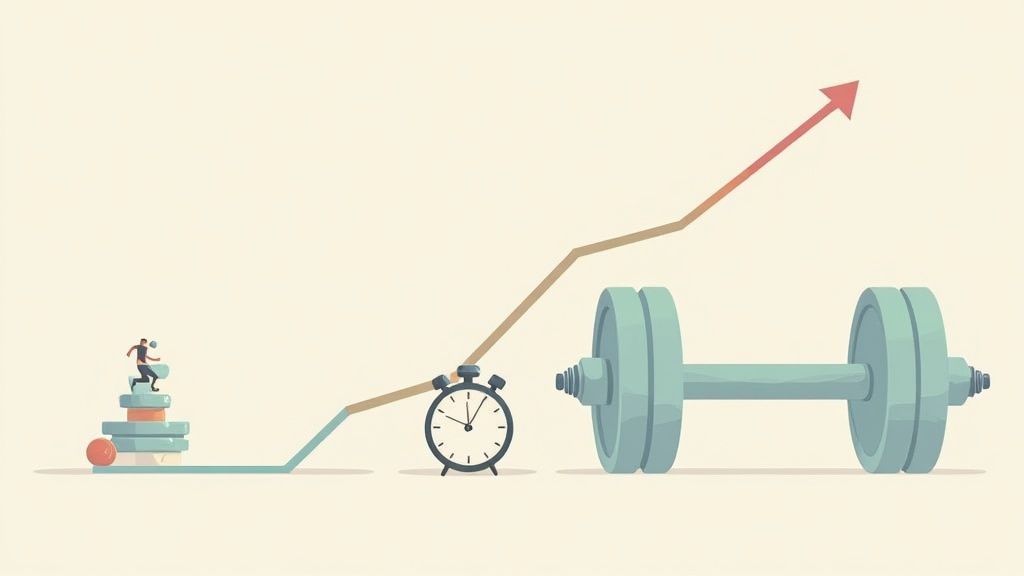How to Overcome Plateau in Weight Loss: Practical Steps

Hitting a weight loss plateau can feel like running into a brick wall. You’ve been consistent, you've seen results, and then... nothing. The scale just stops moving. It's incredibly frustrating, but I can tell you from experience, it’s not a sign you’ve failed. It's actually a sign your body has successfully adapted.
Why Does Weight Loss Stall?
So, what’s really going on when the numbers on the scale get stuck? It's a completely normal biological response. Your body is smart and highly efficient, and it has adjusted to your new, lighter weight and routine.
When you lose weight, a few things change under the hood:
- Your Metabolism Adjusts: A smaller body simply needs fewer calories to operate. Your basal metabolic rate (BMR), which is the energy you burn just by being alive, naturally decreases as your weight drops.
- Your Workouts Get Easier: Remember how tough that workout felt a few months ago? Now, your body has gotten so good at it that it burns fewer calories doing the exact same routine.
- Hormones Shift: Losing weight can also shake up your hunger hormones. Levels of ghrelin (the "I'm hungry" hormone) can go up, while leptin (the "I'm full" hormone) can dip, making you feel hungrier than before.
Understanding this isn't about finding an excuse; it's about finding a new strategy. It's time to work smarter, not necessarily harder.
The Biology Behind the Stalemate
Your body's primary goal is survival. When it notices you're consistently taking in less energy than you're burning, it doesn't know you're trying to fit into old jeans—it thinks there's a famine! As a protective measure, it slows things down to conserve energy.
This is a deep-seated survival mechanism that has kept humans alive for millennia. This decision tree provides a great visual for what's happening when your progress seems to stop cold.

As the flowchart shows, that stalled scale is often a direct result of metabolic adaptation—a natural part of the weight loss journey.
Plateaus Are a Normal, Expected Checkpoint
It’s easy to feel discouraged, but I want you to reframe this. A plateau isn't a dead end. It's a checkpoint. It’s your body’s way of saying, "Okay, I've reached a new normal. What's next?"
And science backs this up. What often feels like a permanent stall is usually just a temporary pause.
A large-scale study with over 6,500 participants revealed a fascinating insight: even with temporary plateaus, two out of three people successfully lost at least 5% of their starting body weight. Researchers noted that what we call "plateaus" are often just normal maintenance phases within a longer, successful journey. You can discover more insights about these weight loss patterns in the full study.
Seeing it this way changes everything. You haven't failed; you've succeeded enough to require a new game plan. Now, let’s look at exactly what that plan should be.
To help you pinpoint what's happening, here's a quick overview of the most common reasons for a plateau and a preview of the solutions we're about to dive into.
Quick Guide to Plateau Causes and Solutions
| Common Cause | What It Means for Your Body | Quick Solution Preview |
|---|---|---|
| Metabolic Adaptation | Your smaller body burns fewer calories at rest (lower BMR). | Recalculate your daily calorie and macro targets. |
| Workout Efficiency | Your body has gotten used to your exercise and burns fewer calories. | Introduce new exercises or increase the intensity (HIIT, weights). |
| Calorie Creep | Small, untracked bites and portion sizes have slowly increased. | Go back to basics with meticulous food tracking for a week. |
| Hormonal Changes | Hunger hormones (ghrelin) increase, making you feel hungrier. | Prioritize protein, fiber, and whole foods to improve satiety. |
| Lifestyle Factors | Poor sleep, high stress, or inconsistent habits are sabotaging efforts. | Focus on improving sleep quality and managing stress levels. |
This table gives you a starting point. Now, let's break down each of these causes and give you the specific, actionable steps to get that scale moving again.
Fine-Tuning Your Nutrition and Calorie Intake
Let's be real: the diet that got you from point A to point B might not be what gets you to point C. As you lose weight, your body changes. It gets lighter, and as a result, it needs less energy just to exist.

That calorie deficit you started with? It might now just be what your body needs to maintain its current weight. This is completely normal. The key isn't to slash calories dramatically but to make smart, strategic adjustments.
Before you change anything, you need to know where you stand. I always tell my clients to track everything they eat and drink for just a few days. This isn't about judging yourself; it's about collecting honest data. You might be surprised where a few extra calories are sneaking in.
Re-Calculate Your Needs
As you shed pounds, your Basal Metabolic Rate (BMR)—the energy your body burns at rest—naturally decreases. Think about it: a 180-pound person burns more calories doing nothing than a 150-pound person does. Your daily calorie target needs to evolve along with your body.
In fact, one 12-month study found that weight loss often slows way down after three to six months. This is that classic plateau, and it’s largely due to these metabolic adaptations. Getting past it requires a new, carefully calculated calorie deficit that reflects your new metabolism.
Prioritize Protein and Fiber
Once you have a new calorie goal, the focus shifts to the quality of those calories. One of the single most effective things you can do is bump up your protein intake.
Here’s why it works so well:
- Protein keeps you full. It’s incredibly satisfying, which helps kill those random cravings and mindless snacking.
- It boosts your metabolism. Your body actually burns more calories just digesting protein compared to fats or carbs. This is known as the thermic effect of food.
- It protects your muscle. When you’re in a calorie deficit, you risk losing muscle along with fat. Protein helps you hold onto that precious, metabolism-revving muscle mass.
At the same time, pack your meals with fiber from vegetables, fruits, and whole grains. These foods are bulky and filling but low in calories, so you can eat generous portions without derailing your progress. Getting a handle on your macros is a game-changer; you can get a good overview by understanding what are macronutrients and micronutrients.
"I see it all the time—people hit a plateau and immediately cut calories too low. This can backfire, causing muscle loss and slowing your metabolism even more. The better approach is to optimize your food choices to fuel your body correctly."
Be Mindful of Portion Creep
This is a sneaky one. Over weeks and months, it's so easy for your portion sizes to get a little bigger without you even realizing it. That extra scoop of rice, the slightly-too-generous pour of olive oil, a larger handful of nuts—it all adds up and can quietly erase your calorie deficit.
This is where that brief food tracking period comes in handy. Get out the measuring cups or a food scale for a couple of days. It’s not forever, just long enough to recalibrate your eyes and get a realistic sense of what a true serving size looks like.
A huge part of this fine-tuning process is learning how to maintain muscle while cutting. You want the scale to go down because you're losing fat, not muscle. Making small, sustainable tweaks to what and how much you eat is always more effective than resorting to a drastic, miserable diet.
Time to Shake Up Your Workout Routine
Just like you need to switch up your diet, your workout routine needs a fresh challenge to keep the scale moving. Remember when you first started? That daily walk probably felt like a huge accomplishment and torched a fair amount of calories. But now? Your body is a pro at it. That’s great for your fitness level, but it’s also a classic reason why weight loss stalls.

To get things moving again, you have to keep your body guessing. This doesn't mean you suddenly need to live at the gym. It's about making smart, strategic upgrades to your current routine. The idea is to ramp up the intensity and mix in some variety to get your metabolism fired up again.
Start Lifting to Build Muscle
If you've been a cardio-only person, adding some form of resistance training is probably the single most effective change you can make. Why? Because muscle is metabolically hungry. It burns more calories than fat, even when you're just sitting on the couch. As you lose weight, it's easy to lose muscle mass right along with the fat, which can put the brakes on your metabolism.
By adding strength training, you're not just preserving that precious muscle—you're building more. This gives you a double win: you’ll look more toned, and you’ll keep your body’s natural calorie-burning engine running on high all day long.
You don't need to transform into a bodybuilder overnight. A few simple additions can make a world of difference:
- Bodyweight Exercises: You can start right now with things like squats, push-ups (on your knees is a great starting point!), lunges, and planks.
- Resistance Bands: They’re cheap, portable, and a fantastic way to add some challenge to at-home workouts.
- Light Weights: Grab some dumbbells or kettlebells and work them into your routine two or three times a week.
The key here is a concept called progressive overload. It just means you’re always pushing yourself a little bit more. That could be doing one extra rep, using a slightly heavier weight, or taking a shorter rest between sets. This constant nudge is what tells your muscles to grow and keeps your metabolism from getting lazy.
Give High-Intensity Interval Training (HIIT) a Try
Another incredible tool for smashing through a plateau is High-Intensity Interval Training (HIIT). This is all about short, explosive bursts of effort followed by a quick recovery. Instead of a steady 30-minute jog, you could sprint as hard as you can for 30 seconds, then walk for 60 seconds to recover. Repeat that cycle for just 15-20 minutes, and you're done.
HIIT is a game-changer for busy people. You burn a massive number of calories in a fraction of the time, and it kicks your metabolism into overdrive for hours after you've finished. This "afterburn effect" is a real phenomenon called Excess Post-exercise Oxygen Consumption (EPOC).
As a general rule, try to change up your routine every four to six weeks. This is just enough time for your body to adapt, but not so long that it gets complacent. By combining the muscle-building benefits of strength training with the fat-burning power of HIIT, you’ve got a one-two punch that can knock out even the most stubborn plateau.
Looking Beyond Diet and Exercise

It’s incredibly frustrating when you’re doing everything “right” with your diet and workouts, but the scale just won’t budge. If you’ve hit that wall, it’s time to look beyond the obvious.
Often, the real reason for a stall isn't the food or the exercise. The culprits are hiding in plain sight: your daily habits. Things like stress, sleep, and how much you move throughout the day have a massive impact on your body's ability to burn fat. These factors might seem small, but their effect on your hormones and metabolism can be the very thing holding you back.
The Hidden Impact of Poor Sleep
Never, ever underestimate the power of a good night's sleep. When you're running on fumes, your body's hormonal balance goes haywire, creating the perfect storm for a weight loss plateau.
Being sleep-deprived causes a spike in cortisol, your main stress hormone. Elevated cortisol tells your body to hang onto energy by storing fat, especially around your belly. It also messes with your hunger cues by cranking up ghrelin (the "I'm hungry" hormone) and suppressing leptin (the "I'm full" hormone). This is the scientific reason you crave junk food when you're exhausted. Your gut health takes a hit, too, which is a big deal when you understand the link between probiotics and sugar cravings.
Getting consistent, quality sleep is non-negotiable for breaking a plateau. Aiming for 7-9 hours per night helps regulate appetite, lower cortisol, and give your body the recovery time it needs to burn fat efficiently.
How Stress Silently Sabotages Your Efforts
Just like a lack of sleep, chronic stress is another cortisol-booster. Living in a constant state of "fight or flight" can absolutely wreck your metabolism. Not only does high stress encourage fat storage, but it also opens the door to emotional eating and completely drains your motivation to be active.
The good news is that managing stress doesn’t require a massive life overhaul. Small, consistent actions can make a world of difference.
- Take mini mindfulness breaks: Even five minutes of deep breathing or quiet meditation can help bring your cortisol levels down.
- Step outside for a walk: Spending time in nature is a well-known and powerful stress reliever.
- Disconnect from your screens: Give your brain a break from the constant buzz of your phone, especially in the hour before you go to sleep.
Harness the Power of NEAT
Finally, let’s talk about a game-changer: NEAT, which stands for Non-Exercise Activity Thermogenesis. It's just a scientific way of describing all the calories you burn from daily movements that aren't structured exercise. Think fidgeting, walking to the mailbox, doing household chores, or taking the stairs.
As you lose weight, your body cleverly tries to conserve energy, and one way it does this is by making you subconsciously move less. By consciously increasing your NEAT, you can give your daily calorie burn a significant boost and push past a plateau without adding another workout to your week.
Making these small tweaks to your routine can feel like a secret weapon against a stubborn plateau. Here's a quick look at how these habits can either hold you back or propel you forward.
Lifestyle Tweaks for Breaking a Plateau
| Lifestyle Factor | Negative Impact (The Plateau Trigger) | Positive Tweak (The Plateau Breaker) |
|---|---|---|
| Sleep | Less than 7 hours a night raises cortisol, increases hunger hormones, and promotes fat storage around the midsection. | Aiming for 7-9 hours of quality sleep regulates appetite, reduces stress, and enhances fat-burning potential. |
| Stress | Chronic high stress keeps cortisol elevated, leading to emotional eating, poor food choices, and reduced motivation. | Incorporating daily stress-management like short walks, deep breathing, or hobbies lowers cortisol and supports mindful eating. |
| Daily Movement | A sedentary lifestyle outside of workouts means your NEAT is low, significantly reducing your total daily calorie burn. | Intentionally adding more movement—taking the stairs, standing more, parking further away—boosts NEAT and reignites metabolism. |
By addressing these often-overlooked areas, you're not just tackling a plateau; you're building a more resilient and balanced foundation for long-term health and sustainable weight management. It's about working smarter, not just harder.
When It's Time to Look at Underlying Health Factors
You’ve done everything right. You're tracking your food, changing up your workouts, and getting enough sleep, but the scale just won’t budge. It's incredibly frustrating, I know. But when you’ve hit a wall this hard despite your best efforts, it might be a sign to look a little deeper than your daily habits.
Sometimes, the real culprit behind a stubborn plateau isn’t your diet or exercise plan at all. It could be an underlying health condition that's secretly making it much harder to lose weight. This isn't about jumping to conclusions or diagnosing yourself, but it is about arming yourself with the right information so you can have a productive conversation with your doctor.
When Your Body Is Working Against You
Certain health issues can directly mess with your body's ability to shed fat. These conditions often throw your hormones and metabolism out of whack, creating a biological barrier that a perfect diet and workout routine might not be able to overcome on their own.
A few common culprits I see are:
- Thyroid Imbalances: An underactive thyroid, or hypothyroidism, can dramatically slow down your metabolism. When that happens, burning calories and losing weight can feel nearly impossible.
- Hormonal Shifts: Conditions like Polycystic Ovary Syndrome (PCOS) are notorious for this. The same goes for the hormonal rollercoaster of perimenopause and menopause, which can completely change how your body stores fat and controls hunger.
- Metabolic Issues: Insulin resistance is a big one. It makes it tough for your body to handle carbohydrates correctly and often encourages it to store fat instead of burning it.
Getting a handle on these factors is key. Our guide on what is metabolic syndrome explains more about how these issues are all connected. If any of this sounds familiar, your next and most important step should be a visit to your doctor.
The Real Link Between Health and Plateaus
The connection between certain health conditions and weight loss struggles is well-established. Take metabolic dysfunction-associated steatotic liver disease (MASLD), for example, which used to be called fatty liver disease. It can make weight management a serious uphill battle.
One study that followed 408 people found that those with MASLD experienced longer and more difficult plateaus. This just goes to show why figuring out how to overcome plateau in weight loss is about more than just seeing a smaller number on the scale—it's about managing your overall health. If you're interested in the science, you can learn more about these findings on liver health and weight loss.
Your doctor is your most important partner in this journey. They can run the right tests to identify or rule out any underlying problems and help create a safe plan that works with your body, not against it.
A plateau that just won't end can feel defeating, but try to see it as a signal. It's your body telling you it's time to dig deeper and get some professional guidance. Working with a doctor can give you the clarity you need to finally break through that wall and get back to making progress safely.
Common Questions About Weight Loss Plateaus
Even when you know what's happening scientifically, hitting a wall in your weight loss journey can bring up a ton of frustrating questions. It's easy to start second-guessing yourself or worrying that the stall is permanent. Let's tackle some of the most common concerns head-on.
How Long Does a Plateau Last?
Honestly, there's no single answer. A true weight loss plateau can stick around for a few weeks or even a couple of months. How long it lasts really hinges on how quickly you pinpoint the underlying cause and how your body decides to respond to the changes you make.
If you’ve been stuck for more than four to six weeks even after trying a few new things, it’s probably time to get a bit more methodical. Take a closer look at your food logs to make sure everything is accurate, think about bumping up your workout intensity, or maybe even chat with a professional to see if something else is going on.
Should I Try a Drastic Cleanse to Break Through?
When the scale won't move, it’s incredibly tempting to go for a quick fix like a juice cleanse or some other extreme diet. But trust me, these drastic measures almost always do more harm than good.
These types of cleanses are unsustainable by design, so any weight you drop will likely reappear the second you start eating normally again. Worse yet, slashing your calories that severely can send your body into "starvation mode." This makes your metabolism slow to a crawl to conserve energy, which can make losing weight even harder down the road.
The best way forward is to make small, smart adjustments to what you're already doing. Think about sustainable changes, like adding a bit more protein to your meals or trying a new workout class, not quick fixes that punish your body.
Can a Cheat Meal Help Break a Plateau?
This is a popular theory, and when you do it right, there’s some logic to it. A planned, higher-calorie meal—often called a "refeed"—can be a great tool for both your mind and body.
- Mentally: It gives you a much-needed break from the daily grind of dieting, which can be a huge help in preventing burnout and keeping your motivation high.
- Physically: A temporary spike in calories and carbs can give a short-term boost to leptin, a critical hormone that helps manage your metabolism and hunger.
The key here is planned. This isn't an excuse for an all-day binge that unravels all your hard work. It should be a single, controlled meal. Think of it as a strategic reset, not a free pass.
Am I Gaining Muscle Instead of Losing Weight?
It's entirely possible, and if this is what's happening, it's a fantastic sign of progress! If you've recently started lifting weights or doing other forms of strength training, you could be building lean muscle at the same time you're shedding fat. This is often called body recomposition.
Muscle is way denser than fat, which means a pound of muscle takes up much less space than a pound of fat. The number on the scale might not budge—it might even creep up a little—but you'll notice your clothes fitting better and your measurements going down. You’ll look and feel leaner. This is exactly why the scale is just one of many tools to track your progress. For a closer look at more tactics, check out these proven strategies to overcome a weight loss plateau.